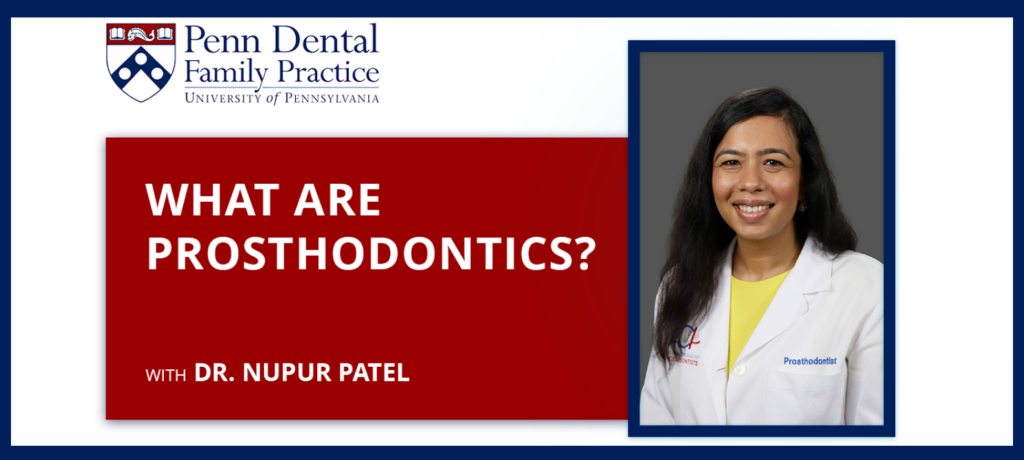Resource Library
Start Reading

If you were starting a home construction or remodeling project—renovating your kitchen, say, or adding a bedroom—you’d want to work with an architect. Their expertise and experience would help your project succeed.
The same principle applies if you’re reconstructing or “remodeling” your smile: You need an “architect.” And prosthodontists are “essentially the architects of the smile,” says Dr. Nupur Patel of Penn Dental Family Practice (PDFP).
Prosthodontics is a dental specialty dedicated to restoring oral function and aesthetics. It focuses on replacing teeth and rehabilitating jaw structures using advanced materials and techniques.
Dr. Patel is a board-certified maxillofacial prosthodontist and an assistant professor of clinical restorative dentistry at the University of Pennsylvania School of Dental Medicine. She also directs the dental school’s Advanced Education Program in prosthodontics.
Dr. Patel recently answered some questions about prosthodontists. Watch the interview below, then read on for more information about these “architects of the smile” and how they blend science and art for outstanding results.
A prosthodontist is a dentist who is an expert in the diagnosis, treatment, and management of complex dental and facial issues. They complete three years of education beyond dental school. “The training encompasses didactic, clinical, laboratory, research, and teaching components,” notes Dr. Patel.
As a result, prosthodontists are experts in planning and carrying out such complex dental procedures as designing and fitting crowns, complete and partial dentures, dental implants, and other dental prosthetics.
They also address issues related to oral function and aesthetics, particularly in cases involving missing, deficient, or malformed jaw structures, and tissue in the face, mouth, jaw, and neck (maxillofacial tissues).
General dentists prevent, diagnose, and treat a wide range of dental conditions, including tooth decay and damaged teeth. They perform such routine yet critical procedures as cleanings, fillings, and root canal therapy.
“There are excellent general dentists that can diagnose and treat simple to moderately compromised dental conditions,” says Dr. Patel. However, patients with “substantially or severely compromised conditions” need dental prosthodontics.
You might benefit from seeing a prosthodontist if you have:
Prosthodontists create customized dental prosthetics to fit the unique anatomy of each patient’s mouth. This personalization ensures the restored teeth function effectively and comfortably.
Dental prosthetics range from conservative—inlays, onlays, dental veneers, and crowns—to large, implant-supported prosthetics. Those more extensive prosthetics include removable dentures or fixed bridges to replace missing teeth (up to an entire upper or lower arch) and maxillofacial prosthetics to restore facial defects due to trauma, surgery, or congenital conditions.
In replacing teeth that are missing or damaged, prosthodontists enhance patients’ ability to chew and speak properly. Restorations restore the teeth’s natural bite and alignment, allowing for improved oral function. Restoring teeth to their proper function and appearance not only helps prevent further dental issues but also promotes optimal oral health.
“Prosthodontists are at the front of the digital evolution in dentistry,” says Dr. Patel. Technological innovations, especially in imaging and modeling, allow for precise treatment planning and improved outcomes.
Digital technologies prosthodontists use include:
Additionally, advancements in dental materials have transformed prosthodontic treatment. Materials like zirconia and lithium disilicate offer durable options for prosthetic dentistry that closely resemble natural teeth. These materials also support the fabrication of more resilient prosthetics and implants.
Dr. Patel stresses that prosthodontists do much more than improve patients’ dental conditions.
“We are able to manage [cases of] kids with congenital deformities such as cleft lip and cleft palate, and help enhance some of their surgical outcomes,” she says. “We treat young adults that have gone through cleft repairs and need oral rehabilitation, or older adults that need [the] return of their oral function from their lifelong dental challenges.”
“When a person is able to speak and smile with confidence,” she says, “this improves their overall well-being. And that’s why this is one of the most rewarding specialties.”
Would you like to talk with PDFP’s “architects of the smile” about how dental prosthodontics could help you? Schedule your appointment online now or call us at 215-898-PDFP (7337).